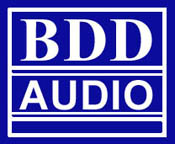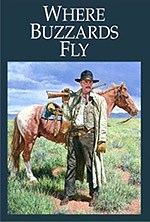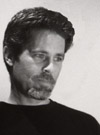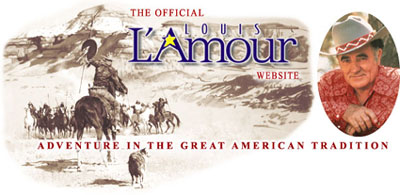| |
The
History
of
Louis L’Amour
Audio Dramas
by Beau L'Amour
About
20 years ago, several mainstream publishers began to
notice the growing audio publishing market. There was
a lot of experimentation as different companies began
to explore the various possibilities in the business
of putting books on tape. Several forms, other than
the single voice reading typical of today, were initially
developed.
Because
of the reliability of L’Amour sales, Bantam has often
used a L’Amour product as it’s opening foray in a new
and untried arena.
Jenny Frost, an executive with the new division,
Bantam Audio Publishing, came out to California to discuss
the medium with Louis.

The
initial approach was to use L’Amour short stories for
a shorter, and when compared to an unabridged novel,
less expensive product. Louis was naturally hesitant to put his old,
and often hastily written, short stories into a new
and untried market. To give the stories a greater “production value”
and to differentiate the Bantam product from the rest
of the marketplace, Louis and Mrs. Frost decided to
present them in a format similar to the classic radio
dramas of the 1930s and ‘40s.
Veteran
producer David Rapkin and director Charles Potter were
hired and started creating a sample show; "Where
Buzzards Fly."
To create the audioplay, the story was simply
transcribed into script form, giving the actors each
line of dialogue and handing the descriptions to a narrator.
Once production was finished it became obvious
that while Buzzards was exactly the right length of
60 minutes, many other short stories wouldn’t be.

So,
unlike the normal “book on tape” where an actor reads
the author’s text verbatim, the dramatized programs
became adaptations of the original work.
A completely new script was written in a manner
specifically intended to present the story as drama. Often there are quite a few differences from
the novel or short story; differences that enable the
story to be told more through scenes than narration
and allow the production to meet a specific (usually
60 minute) requirement as to length.
I
first came into the program to oversee the adaptation
process along with casting and other aspects of production.
Many of the scripts that followed were written
by Charles Potter, Katherine Doughty, Charles Van Eman,
and myself.
During
the time I was working as the Supervising Producer,
I wrote and directed Unguarded Moment, produced by Paul
O’Dell and starring my friend John Putch, in order to
try to teach myself the production end of the business.
I supervised many scripts (and wrote and rewrote quite
a few myself), training both young and old writers how
to write for the particular type of production that
we had developed. Over the years I believe we did some
sixty dramatized shows. In the beginning we were doing as many as six or seven a year.
The
few times I produced an audio drama on my own in Los
Angeles and when I eventually began cutting our shows
for commercials so that we could run them on the radio,
I worked in the recording studio with Paul O'Dell, my
old friend and eventually the webmaster of the Louis
L'Amour web site.
When the time came to produce Son of a Wanted
Man both Charlie Van Eman, Paul O’Dell, as well as David
Rapkin in New York, were there to help.
I
believe that at this time, the Louis L’Amour Dramatized
Audio Productions have had the longest production run
and the greatest popularity of any drama series created
for the audio publishing market.
|
|
|
The
History of
"Son of a Wanted Man"
by Beau L'Amour
Some time in the
1980s I ended up working as a sound engineer on an independent
film for a friend of mine named John Putch. The film was called
"Waiting to Act" and it documented the fictional
and often comical struggles of a number of aspiring young actors
who worked in a restaurant in Hollywood. There were a whole group
of us including myself and Paul O'Dell, that just like the actor/waiters
in the movie, were trying to find our places in the business of
theater and movies. Occasionally we came together on films where
one or another of us had a position of some small responsibility.
 The
lead role in Waiting to Act was played by a guy named Charles
Van Eman and though we did not know one another particularly well,
we both stayed in the group and eventually even worked on another
film, doing the same jobs ... Charlie in front of the camera while
Paul and I were far behind it. The
lead role in Waiting to Act was played by a guy named Charles
Van Eman and though we did not know one another particularly well,
we both stayed in the group and eventually even worked on another
film, doing the same jobs ... Charlie in front of the camera while
Paul and I were far behind it.
 Charlie
was also involved as an actor in the audio production of "Merrano
of the Dry Country", which I wrote and directed and Paul
produced and edited. It was an attempt to produce a real state
of the art show and a great improvement over "Unguarded
Moment". Also in the cast were Will McMillian ("Son
of a Wanted Man's" Ben Curry) and Nicholas Ballas (Molina).
Howard Gale, "Son of a Wanted Man's" engineer,
also helped out. Charlie
was also involved as an actor in the audio production of "Merrano
of the Dry Country", which I wrote and directed and Paul
produced and edited. It was an attempt to produce a real state
of the art show and a great improvement over "Unguarded
Moment". Also in the cast were Will McMillian ("Son
of a Wanted Man's" Ben Curry) and Nicholas Ballas (Molina).
Howard Gale, "Son of a Wanted Man's" engineer,
also helped out.
At some point
Charlie and I started talking about writing, and eventually discussed
collaborating on a movie script. Soon we began an adaptation of my father's novel,
Son of a Wanted Man. Together we wrote a draft or two but around this same time Charlie went off and spent
the next several years on the East coast. Throughout that time,
he made appearances as an actor in other Louis L'Amour audios
that were recorded in New York City.
After my father had passed away I began focusing more and more on
working in the publishing and audio publishing business where
I supervised the writing and production of our dramatized shows
along with designing cover art, editing and occasionally ghost
writing parts of books of short stories, producing a fiction magazine,
and writing a great deal of jacket copy. Slowly my attention had become more and more diverted from working in film.
Eventually the Bantam program of
dramatized audios was slowing down, Charlie Van Eman was back in
LA and working on the Louis L'Amour Biography Project, Paul had
moved to Washington State, and I was looking into other things
altogether. The script for "Son of a Wanted Man"
still sat on my shelf and continued to call to me to put it into some form of production. I still had a love for
theater that was not being satisfied in the book business. I realized
that I didn't need film to do what I loved, especially as the
costs and politics withheld so much of the enjoyment of the process.
Perhaps I could make one more try at the blind art of radio.
A few years ago we decided that
Louis L'Amour need a better presence on the world wide web. It
was an area that I knew very little about so I called Paul to
ask a few, rather uninformed, questions. The last of these questions
was if he knew anyone who might run a web site for us. Purely
by accident, I had hit the right moment.

Paul and I started coming up
with the concepts for the Louis L'Amour web site (www.louislamour.com).
We also imagined several projects that we could do in conjunction
with it, things that the opportunity of working together again
would make possible. The first of these was to resurrect our old
love of "Radio Drama" style productions. I dusted off the
script to "Son of a Wanted Man" and took a careful
look at it. I had learned a few tricks in the intervening
years so I went to work on it.
THE
MAKING OF
SON OF A WANTED MAN
Pre-Production
and The Script
Turning
a novel into an audio script
Pre-Production
and Casting
Getting it all
on "Tape"
Recording
Session
Recording
Sound Effects
Putting the
Pieces Together
Editing
and Sound Effects
Music
Mixing
and Mastering.
What's
Next?
|
|



 The
lead role in Waiting to Act was played by a guy named Charles
Van Eman and though we did not know one another particularly well,
we both stayed in the group and eventually even worked on another
film, doing the same jobs ... Charlie in front of the camera while
Paul and I were far behind it.
The
lead role in Waiting to Act was played by a guy named Charles
Van Eman and though we did not know one another particularly well,
we both stayed in the group and eventually even worked on another
film, doing the same jobs ... Charlie in front of the camera while
Paul and I were far behind it.
 Charlie
was also involved as an actor in the audio production of "Merrano
of the Dry Country", which I wrote and directed and Paul
produced and edited. It was an attempt to produce a real state
of the art show and a great improvement over "Unguarded
Moment". Also in the cast were Will McMillian ("Son
of a Wanted Man's" Ben Curry) and Nicholas Ballas (Molina).
Howard Gale, "Son of a Wanted Man's" engineer,
also helped out.
Charlie
was also involved as an actor in the audio production of "Merrano
of the Dry Country", which I wrote and directed and Paul
produced and edited. It was an attempt to produce a real state
of the art show and a great improvement over "Unguarded
Moment". Also in the cast were Will McMillian ("Son
of a Wanted Man's" Ben Curry) and Nicholas Ballas (Molina).
Howard Gale, "Son of a Wanted Man's" engineer,
also helped out.
